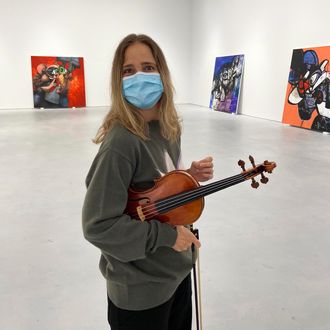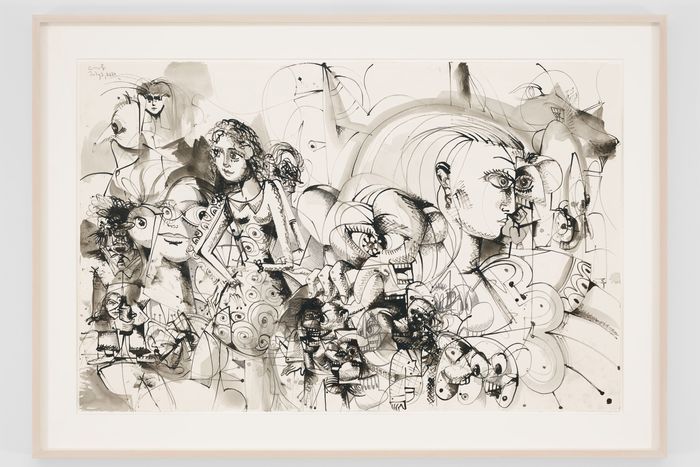
“It’s a bizarre sort of painter’s dream to not have to go to events or see people; you’re just home,” says artist George Condo of being forced to stay in his studio and work during the lockdown. “To live like that without there being a pandemic would be amazing, but for performers it’s just an absolute nightmare.” Unfortunately, his partner, solo violinist Leila Josefowicz, couldn’t play in concert halls, and for the first few months, they were separated; he in East Hampton and she in Scarsdale. So the couple worked up a collaboration, at first from a distance.
Condo made a series of new paintings and drawings for his show “Internal Riot,” which opened at Hauser & Wirth earlier this month. Josefowicz spent her time apart from him mastering Bach partitas. Together, they teamed up on A Linea Evocativa (2020) A Drawing for Violin Solo (Dedicated to George and Leila), a new piece of music that Condo commissioned from German composer Matthias Pintscher to be played by Josefowicz at Hauser & Wirth. The piece was based on a drawing made by Condo during quarantine titled A Drawing for Violin (Dedicated to Matthias Pintscher and Leila Josefowicz, 2020), and will have its (virtual) world premiere on Friday at 2 p.m. via livestream (you can register to “attend” the event here). Ahead of the performance, we spoke to Condo and Josefowicz about commissioning the piece, performing virtually, and creating art during lockdown.
At what point in quarantine did the idea for the collab come about?
George Condo: March, I think. We started thinking about the idea that it was going to be very difficult for musicians to perform with all of the concert halls being shut down, and we began thinking about what repertoire there would be for a solo violin, at which point Leila began working on the Bach partida. She was furiously working through that for March, April, and May, and then I think it was around then that we asked, Who could we think of who could write an amazing piece for solo violin? Leila, you can talk about Matthias and how you played his violin concerto.
Leila Josefowicz: It’s been an amazing musical and artistic journey. When the virus hit, George and I were talking about how I could communicate and express music singularly after so many years of doing solos with giant orchestras. It wasn’t something I’d ever done in my career. George has always loved Bach so much, and I’ve always focused on contemporary music, so this was my way to reinvite myself into loving that repertoire again. I’ve played so much newer music and collaborated with so many composers, so we started thinking about who would be really a dream composer to ask to do this project with us. Matthias Pintscher is a real genius of creating different sounds and feelings and textures in new music, and he’s also a dear friend of mine and a New Yorker, so I thought he would be a really great person to ask. It just seemed like a beautiful thing to do in the midst of an artist crisis in performance. It certainly transformed my existence in so many different ways.
When you say it transformed your existence, how so?
LJ: As performers, we thrive on the adrenaline buzz and thrill of expressing and communicating with people, and this livestream tomorrow still enables me to have that gift of communication. It’s also along the lines of what I’ve loved to do over the years, which is give a great creator, a composer such as Matthias Pintscher, a voice. I consider myself the messenger for great musical art, and I get to do this tomorrow, which is so thrilling. Of course, George is the genesis and the catalyst for all of this. So, thank you, George.
GC: You’re welcome.
George, can you tell me about the drawing from “Internal Riot” that inspired the commission?
GC: I’d been thinking about the idea of linearity. With the commission, normally someone like Matthias would be conducting somewhere, but he was home, so I sent him an image of this drawing just as a kind of inspiration to say I’m thinking a lot about the linearity variations, and also the transformations of personalities within this crisis that we’re dealing with. How it’s sort of tearing people apart, and pulling them back together again. Matthias sent me a note to say how this drawing really was a seed and an inspiration for him in the sense that it flows with one single line throughout the piece, and then various textures start to happen. At first you don’t notice them, but you do when you start to really look at the drawing — there are washes; there are grays; there are varied tones of black and white. I think about it as a kind of automatic writing, like someone like Jack Kerouac just sitting down at the typewriter and going from start to finish without looking back. When I’m drawing, that’s what I do. I start; I don’t hesitate; I do everything in one go. I believe that’s how Matthias approached the piece — as notes arrived in his brain, they went straight from there to the pencil onto the music staff. So the piece isn’t particularly reflecting one image; it’s more the way I draw. I think he thought, Why not just compose like that?
LJ: It was amazing. It’s sort of a joke in my world that composers are often extremely late with their compositions; it’s just the way it is. In this case, Matthias had probably a maximum of two weeks to just say he’s thinking about it, and then maybe a week later he was done. I was almost like, Are you sure?
Maybe that productivity is a silver lining.
LJ: It really was an artistic explosion.
Leila, when you first played the piece what did you think? Was there anything surprising about it to you?
LJ: I take things very literally at first, that the manuscript is a roadmap to aural expression. I have to take time with it, and first go through painstakingly all of the notes, the phrases, the lines. Matthias has talked to me a lot about the piece and that symbolically there’s some very smooth and fluid gestures that are kind of explosively interrupted by other gestures. In some ways all of our existences right now are like that: Sort of, breathe, breathe, and then you get hit with something, but you have to keep breathing and go back to that mode of existence of staying in the moment and trying to make the best of things. Symbolically, that’s a lot of what this piece is about.
This project is very much in response to this moment, which, with the vaccines coming, looks to finally have an end point. Does it feel like a quarantine time capsule to you in some ways?
GC: Yeah, it was really just an expression of the love we all have for each other in a lot of ways, and our pain within this quarantine, where you feel everybody’s pain in a strange way. We just wanted to release something positive into the world to alleviate some of that.
LJ: The other inspiring thing to me about it is that as humans we feel so much right now, so many different emotions hit you in the chest throughout the day. But there’s something kind of amazing about when you create art; you’re not immersed in the eruption of emotions. It’s hard to explain, but you almost have to have a distance to do the best creation.
How would you describe the experience of making art in lockdown?
LJ: It’s funny, people always said to me when I was in my teens and 20s, “Play this performance like it’s your last.” March 8 was literally my last pre-pandemic concert. Now, creating for people with my own two hands has this incredible urgency that never could have been duplicated in the past. You have to do it. You have to create something. Some fantastically inspired art comes from that.
GC: For me, it’s such a different experience. When I was a kid growing up in a really small New England town, I would just go up to my bedroom and paint. There was absolutely nothing to do, except look at snow — you couldn’t go to the city; you couldn’t do anything. All of a sudden this quarantine happened, and I was like, This is like a flashback of when I was 14 and the only way to keep yourself entertained was reading books or painting.
Another piece of this project is the documentary you did with Tom Piper chronicling the work — can you tell me about that?
GC: Leila and I couldn’t see each other for months, so I started thinking, Why doesn’t Leila start doing some iPhone photography of her playing various movements of the Bach, and I’ll just do some iPhone on a stand filming me painting, and we’ll just juxtapose the painting, filmmaking, and music, and putting them together with a split screen or something. Then I realized that was way over my head. We needed a pro, and we thought Tom Piper had made beautiful documentaries, and he’s a really nice guy. Once we started to be able to see each other, Leila would get tested and come out to Long Island for three or four days. So she would be practicing the Bach in the studio while I was getting this exhibition painted, and Tom got all of this great footage of her just ripping through Bach and me banging away on the paintings. Then we started to think that he could get all kinds of aspects of nature, the environment, the times that we live in, and capture all of that in a film.
“George Condo: Internal Riot” is at Hauser & Wirth, 548 West 22nd Street, through January 23, 2021. Register to see “In Performance: Leila Josefowicz” on November 20 at 2 p.m. here.


